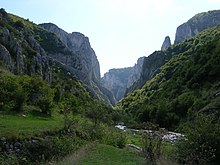

The flora of Romania comprises around 3,450 species of vascular plants, which represents around 30% of the vascular flora of Europe.[1]
The three major vegetation zones in Romania are the alpine, steppe, and forest zones.[2] The latter can be subdivided (depending on soil, climate, and altitude) into regions dominated by the Norway Spruce, European Beech, and various species of Oak,[2] together with less widespread vegetation types such as the Dinaric calcareous block fir forest.
The Danube Delta is the largest continuous marshland in Europe.[3] Vegetation in the marshland is dominated by reeds, with Willow, Poplar, Alder, and Oak on the higher ground.[3] In 1991, this area became part of the UNESCO list of World Heritage Sites.[3] The delta supports 1,688 different plant species.[4]
The meadow-steppe grassland areas of Romania are also species-rich, but endangered.[5]
Among the flora of Romania are medicinal plants such as Arnica montana, Primula veris, Tussilago farfara, and Atropa belladonna.[1]
All the genera and species of plants found in Romania are listed in the 1977 work The Flora of Romania Illustrated Determinator of Vascular Plants.[6]
- ^ a b Danela Murariu; Silvia Strajeru; Constantin Milica; Steluta Radu (2004). "Status of the Romanian medicinal and aromatic plant collection". In Dea Baričevič (ed.). Report of a Working Group on Medicinal and Aromatic Plants: First Meeting, 12–14 September 2002, Gozd Martuljek, Slovenia. Bioversity International. pp. 109–113. ISBN 978-92-9043-633-1.
- ^ a b Valeriu Enescu. "Forest Genetic Resources Conservation in Romania". Forest Genetic Resources N.24. Organizația Națiunilor Unite pentru Agricultură și Alimentație. Retrieved 6 April 2009.
- ^ a b c "Danube Delta". UNESCO's World Heritage Centre. Retrieved 2008-01-10.
- ^ Ellen Wohl (2010). A World of Rivers: Environmental Change on Ten of the World's Great Rivers. University of Chicago Press. p. 130. ISBN 978-0-226-90478-8.
- ^ John Akeroyd; Nat Page (2007). "The Saxon Villages of Southern Transylvania: Conserving Biodiversity in a Historic Landscape". In Dan Gafta; John Akeroyd (eds.). Nature Conservation: Concepts and Practice. Springer. p. 205. ISBN 978-3-540-47228-5.
- ^ Al. Beldie (1977). Flora României Determinator Ilustrat al Plantelor Vasculare (in Romanian). Vol. I. Editura Academiei R.S.R.